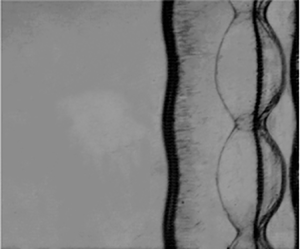Published online by Cambridge University Press: 27 July 2023

The reshocked Richtmyer–Meshkov instability (RMI) is examined in three different configurations via shock-tube experiments: RMI at a single-mode interface with a planar reshock (configuration I); RMI at a flat interface with a sinusoidal reshock (configuration II); RMI at a single-mode interface with a sinusoidal reshock (configuration III). The sinusoidal reshock is created by an incident shock reflecting off a sine-shaped wall surface. For all three configurations, the initial conditions of the experiment are specially set such that the interface evolution is at the linear stage when the reshock arrives. It is found that the amplitude of the reshocked interface increases linearly with time for all three configurations. For configuration I, the post-reshock perturbation growth depends heavily on the pre-reshock amplitude and growth rate, which can be predicted by a modified Mikaelian model (Phys. Rev. A, vol. 31, 1985, pp. 410–419). For configuration II, velocity perturbation associated with the non-uniform rippled reshock plays an important role in the instability growth. For configuration III, the post-reshock instability growth is much quicker (lower) than in configuration I when the sinusoidal reshock is in phase (out of phase) with the interface. A major reason is that for the in-phase (anti-phase) case, the velocity perturbation gives rise to an instability growth with an identical (opposite) direction to the pressure perturbation. A linear theory is developed that takes velocity perturbation, pressure perturbation and pre-reshock growth rate into account, which gives a reasonable prediction of the growth of the reshocked RMI in configurations II and III.